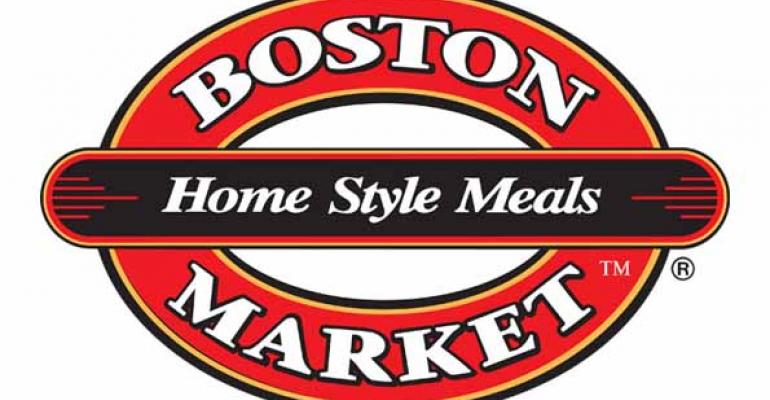Boston Market appears to have turned a corner after years of downsizing.
From 2007, when it was bought by Sun Capital Partners, and 2013, the Golden-Colo.-based fast-casual chain reduced the number of its locations from 630 units to 462 units nationwide. In 2014, it opened three restaurants, and is looking to open at least 10 locations this year.
Chief executive George Michel recently discussed his plans for the chain with Nation’s Restaurant News, as well as lessons learned working in the chain’s restaurants on its busiest day, Thanksgiving.
What do you learn from spending Boston Market’s busiest day, Thanksgiving, working in one of the restaurants?
I’ve learned a lot about food preparation and things we did that were adding more work for the staff. So we then went back to the suppliers and they helped us with some procedures that made it easier. We’ve cut a lot of work out of the restaurant just by having the pies pre-sliced. We go through at least 200 to 300 pies per restaurant on Thanksgiving Day.
We used to have our turkey breast, which we cook on the rotisserie, come in frozen, so they had to thaw it and create projections [for how much turkey they would use] to do that, and you also need freezer space and cooler space. So now we get it chilled. That’s a huge procedure for the staff not to worry about.
Now we have a commissary that prepares our gravy, so we don’t have to do it from the restaurant, and next year we’re going to look at probably going into a couple of industrial areas where there’s already maybe a restaurant that’s going out of business. We’ll grab that space and use it for catering so that we don’t put that pressure on restaurants.
I also noticed a bit of a flaw in the design. We had a cooler in between the hot case and the cash registers, so the staff had to take the food and take a few steps and give it to the cashier, and the three cashiers were jammed together. So we removed that cooler, bought a standup cooler and embedded it into the wall on the side where the customers line up. Now there’s more room for the cashiers to work, so it’s much easier on our employees and our customers.
How do you like spending Thanksgiving working in the restaurants?
My wife is not involved in the business, but she volunteers [for Thanksgiving] because then we get to spend the time together. She puts on a uniform and does the dining room, and I do the back and watch the operations to really see what we can do to simplify the lives of our employees for next year.
Has your wife noticed ways to improve service?
When we were in Miami two years ago, she had a tough time because 50 percent of the people who walked in could only speak Spanish. They couldn’t speak a word of English and they were grabbing her because she’s from Lebanon, so she almost looks like she’s from South America, so they would be upset that she couldn’t speak the language. And we realized that we needed [point-of-purchase, or POP, materials] and menus in Spanish. So that’s why we created those menus, and it’s helped our business with that population in Texas, California and Florida. I wouldn’t have picked that up if I hadn’t worked in the restaurants and seen the struggles they were going through.
Does having POP in Spanish help increase the number of Spanish-speaking visitors, as well as speed of service?
Yeah, and also [eases] the frustration. A lot of our staff are Spanish-speaking people, and it really helps us a lot having the two languages.
New menu items, 2015 expansion
(Continued from page 1)
What else are you working on?
We’ve changed the menu board to an electronic one, which makes a difference in flexibility. And we’ve also opened the first two [Boston Market units] on army bases — one in October at Fort Bliss and the other in November at Fort Meade, and they’re performing 100-percent better than the projections that both parties had, so now they’re talking about doing six to eight [Boston Market units on army bases] just next year alone. And the feedback we’re getting is phenomenal, especially from the U.S. troops who are coming home after they’ve been in deployment for three or four months, because they have to be on base for awhile. They say this is the closest to a home-cooked meal.
We’re trying to finalize a development agreement for 50 restaurants in the Middle East. I was in Dubai and met with a group that’s in the hotel business there.
Are you planning new menu items?
We’re going to launch a new product in April. It’s a pulled barbecue pork. We tested it in three markets and it scored extremely well, and we’re going to feature it on its own, as a sandwich and also as a combo meal with rotisserie chicken. It went to almost 15 percent of menu mix in test.
And then we’re developing beef ribs for the Middle East, because we can’t serve pork ribs there. So we’re looking at a prime rib that’s excellent, cooked in a rotisserie. The taste is out of this world — just like having a prime rib steak at home on the barbecue.
You opened three restaurants in 2014. What does 2015 look like?
We’re looking at 10 to 12 [openings] minimum in 2015, just in the U.S. There will probably be two at food courts, probably four more in the New York area. The army probably will do six to 10. That would be a great year for us. And then if we open one or two in the Middle East, that would give us that penetration there.
Contact Bret Thorn at [email protected].
Follow him on Twitter: @foodwriterdiary





